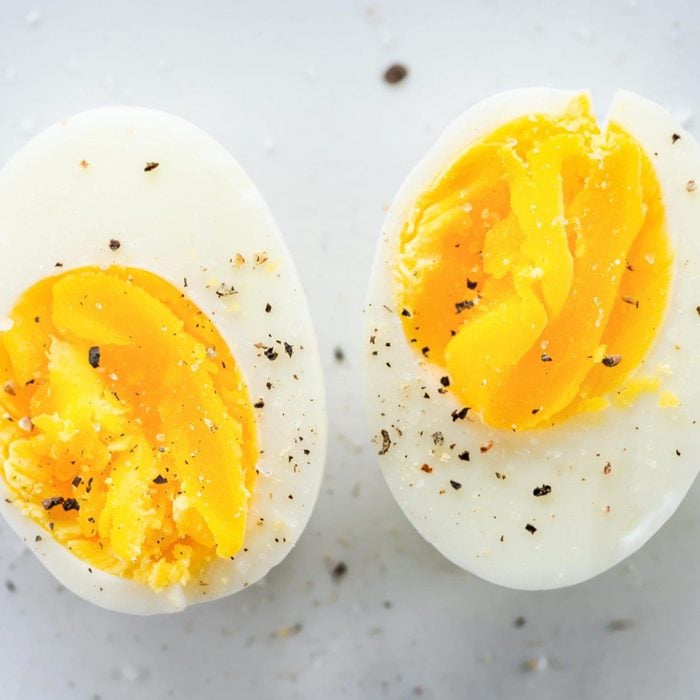This Weight-Loss Fad May Increase Pain and Inflammation
Updated: Dec. 21, 2022

A recent study found this diet could actually make you hurt in places you never did. Here's an easy formula to shift your nutrition quotient.
It can be tempting to look for those diets that provide clear guiderails to achieve weight loss. Cut out things like fruit and wheat and pile high on proteins? Many people find approaches like this can work—but some doctors suggest they can lead to other health issues. As a liver doctor recently told us: “[…Y]ou never want to try to choose a healthy choice for one [goal] and increase the risk of another problem, like cardiovascular disease.”
So just because a popular weight-loss tactic promises speedy weight loss doesn’t mean it’s healthy. In fact, if you’re trying to lose weight just to feel better all around, one fall 2022 study has shown one particular fad diet can actually increase the degree of pain you feel.
The Best and Worst Diets for Your Cholesterol, Says UCLA Cardiologist
How eating a high-fat diet affect the body’s pain response
The study, published in Scientific Reports, found a significant link between high-fat diets (like the ever-so-popular ketogenic diet) and increased pain and inflammation in the body. While previous research had already shown that high-fat diets can increase pain sensitivity, the current study found how this particular weight loss fad can actually sensitize the pain response to parts of the body that don’t typically experience pain.
How exactly does a high-fat diet cause increased pain? Researchers from this study made this conclusion after studying the pain response from groups of mice over an eight-week period. One group consumed a “standard chow diet” for the allotted time frame, while the other ate a high-fat diet.
The mice who ate the high-fat diet did not develop obesity or hyperglycemia, but researchers did notice these mice exhibited a higher mechanical allodynia response—a bodily responses that would ordinarily feel painless—like a light touch, or the brushing of hair.
The Most Heart Attacks Happen This One Day of the Year—Doctors’ Tips to Prevent “Holiday Heart”
Even though this type of response can be common for those with excess abdominal fat, the study found that this pain response could become common for anyone consuming a high-fat diet.
“It became clear, surprisingly, that you don’t need an underlying pathology or obesity. You just needed the diet,” says co-author Dr. Michael Burton, assistant professor of neuroscience in the School of Behavioral and Brain Sciences at the University of Texas in Dallas, in a press release. “This is the first study to demonstrate the influential role of a short exposure to a high-fat diet to allodynia or chronic pain.”
Although scientists do make clear that this study is done with animals, providing limited conclusions for humans, the research is promising for linking high-fat diets and chronic pain.
Here’s How Much Exercise You Need to Counteract Sitting All Day, Says Study
Too much saturated fat can cause inflammation
While research linking dietary choice, inflammation and chronic pain are still in the early stages, this study does give some understanding of how inflammation could be a major benefactor of the body’s pain response after consuming a high-fat diet.
“Some recent research shows a high-fat diet can contribute to gut inflammation and lead to fat accumulation in other tissues, which can promote systemic inflammation in the body,” says Mackenzie Burgess, RDN, recipe developer at Cheerful Choices from Fort Collins, CO.
Burgess points out (and the study supports) the idea that excess amounts of saturated fat typically cause increased inflammation in the body, which can lead to increased feelings of pain. If you’re looking for an easy way to identify saturated fats, these are the types of fats that become solid at room temperature—like butter, coconut oil, cheese, dairy products and meats—all foods that are generally deemed OK for many high-fat diet plans.
The 2020-2025 Dietary Guidelines for Americans state that no more than 10% of your calories should come from saturated fat sources each day, and Burgess says it’s best to focus on unsaturated fats instead. “This includes monounsaturated fats found in foods like olive oil, avocados, and nuts as well as polyunsaturated fats found in fatty fish and seeds,” she says.
Eating These Foods Can Lead to Premature Death, Says New Study
The body needs a balance of macronutrients
Yes, it’s important to have a healthy amount of fat in the diet, but fat shouldn’t be the only macronutrient you prioritize in your diet. Guidelines suggest that 20% to 35% of your calories should come from fatty foods, while the other portion should come from protein (10% to 35%) and carbohydrates (45% to 65%), ensuring the body gets the nutrients (like fiber!) and energy it needs.
“I always tell clients that balance is key, and for good reason,” says dietitian Burgess. “Each macronutrient provides a distinct and important function in the body. For example, protein helps us build muscle strength, maintain a healthy immune system, and transport molecules throughout our body. Carbs are the body’s preferred source of energy and carbohydrate-rich foods provide us with many important vitamins and minerals. Fat certainly has its place too—it helps us absorb certain vitamins, protects our organs, and supports cell function. However, excess amounts of fat can contribute to suboptimal health outcomes.”
